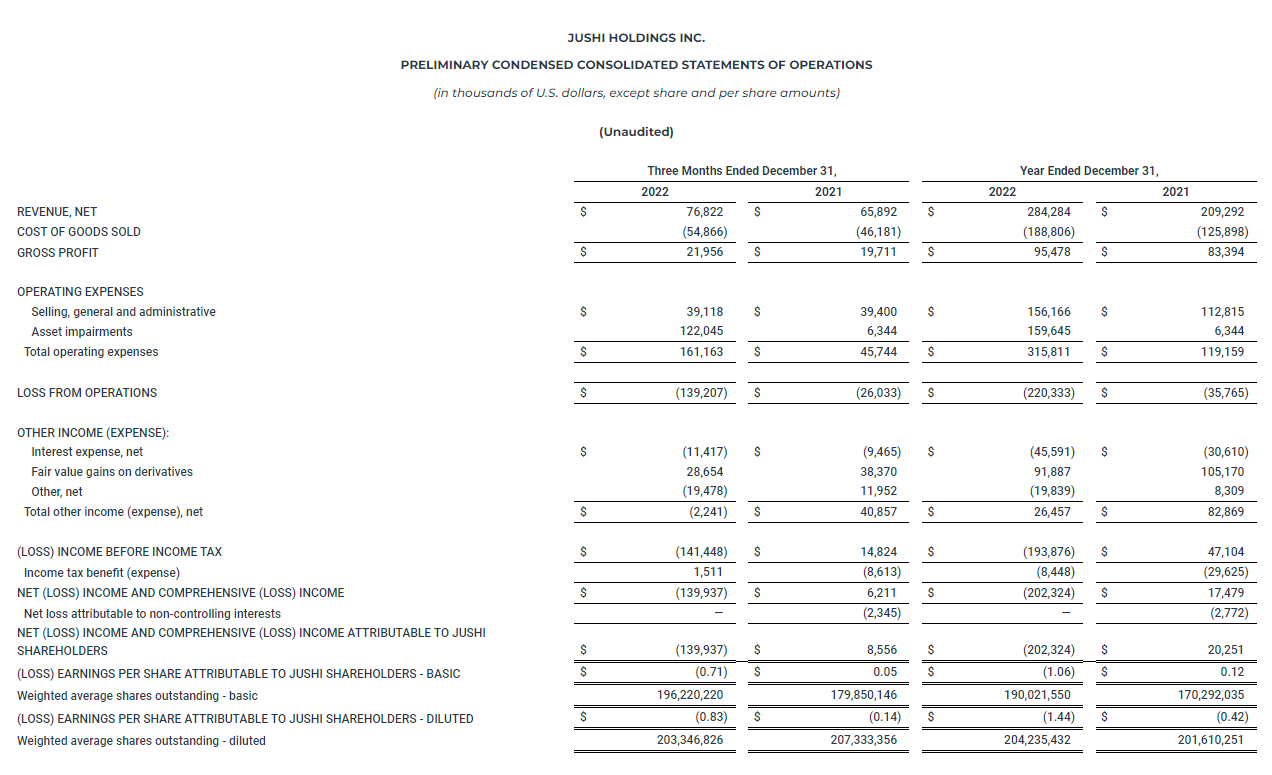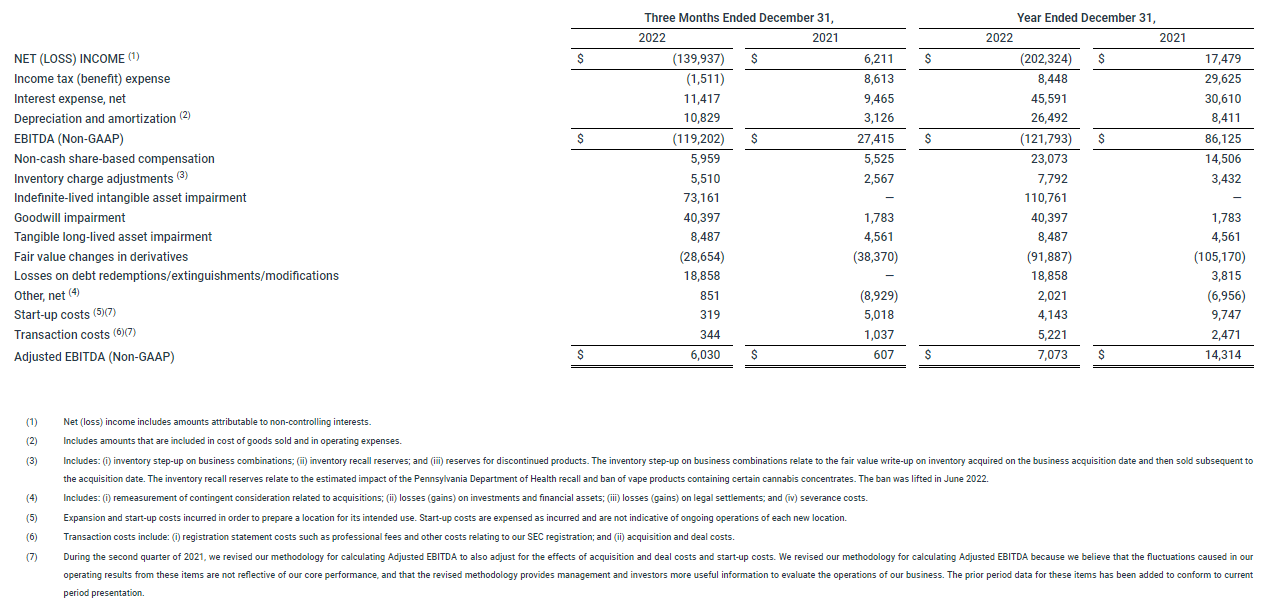
Jushi Holdings Inc. Reports Unaudited, Preliminary Fourth Quarter and Full Year 2022 Financial Results
- Q4 2022 Revenue Increased 16.6% YoY to $76.8 million and FY 2022 Revenue Increased 35.8% to a Record $284.3 million
- Solidified Retail Network with Seven New Store Openings and 35 Operational Dispensaries Nationwide in 2022
BOCA RATON, Fla., March 31, 2023 (GLOBE NEWSWIRE) — Jushi Holdings Inc. (“Jushi” or the “Company”) (CSE: JUSH) (OTCQX: JUSHF), a vertically integrated, multi-state cannabis operator, is pleased to announce its unaudited preliminary financial results for the fourth quarter (“Q4 2022”) and full year ended December 31, 2022 (“FY 2022”). All financial information is provided in U.S. dollars unless otherwise indicated and is prepared under U.S. Generally Accepted Accounting Principles (“GAAP”).
Financial Highlights
Q4 2022
- Total revenue of $76.8 million, an increase of 16.6% year-over-year and 5.5% sequentially
- Gross profit of $22.0 million, an increase of 11.4% year-over-year
- Net loss of $139.9 million
- Adjusted EBITDA1 of $6.0 million
- Reduced inventory by $7.0 million versus the prior quarter
- Cash, cash equivalents and restricted cash were $27.1 million
FY 2022
- Total revenue of $284.3 million, an increase of 35.8% year-over-year
- Gross profit of $95.5 million, an increase of 14.5% year-over-year
- Net loss of $202.3 million
- Adjusted EBITDA1 of $7.1 million
- Reduced inventory by $8.2 million versus the prior year
1 See “Use of Non-GAAP Financial Information” and “Unaudited Reconciliation of Net (Loss) Income to Adjusted EBITDA” below.
Fourth Quarter 2022 Operational Highlights
- Made significant progress on the Company’s expansion projects in Virginia and Pennsylvania, expanding total overall canopy to 69,310 sq. ft. and increased total annual biomass capacity to 49,121 lbs., as of year end
- Grew Virginia patient base by ~188% year-over-year, concluding FY 2022 with over 12,000 Jushi active patients and the total number of certified patients in our footprint to date in Virginia is approximately 22,620
- Closed US$73.1 million debt financing used to redeem outstanding existing senior secured notes and extend our senior debt maturity to December 2026
- Relocated the Beyond Hello™ Westside dispensary in Pennsylvania to Dickson City in the Greater Scranton Area
- Launched a suite of products in California exclusively at Beyond Hello™ retail locations, including Sèchè pre-roll singles, Tasteology fruit chews, and The Lab vapes
- Strengthened Board of Directors and senior leadership with appointments of Bill Wafford as an Independent Director and Chair of the Audit Committee, and Tobi Lebowitz to Chief Legal Officer and Corporate Secretary
Recent Developments
- Opened the 36th and 37th retail locations nationwide, establishing a fifth vertically integrated state-level operation with the first Beyond Hello™ medical dispensary in Ohio, and adding a fifth medical cannabis dispensary in Arlington, Virginia
- Continued focus on cost-savings and efficiency optimization plan, reducing employee headcount from approximately 1,570 total employees at peak in 2022 to approximately 1,310 total employees today. We expect to move to a new labor model resulting in a total estimated 50% labor hour savings since April of 2022.
- Made a series of leadership appointments, including hiring Michelle Mosier as Chief Financial Officer, and appointing Nichole Upshaw to Chief People Officer, and management changes of Shaunna Patrick to Chief Commercial Director, and Trent Woloveck to Chief Strategy Director
- Secured up to US$10.0 million equipment lease financing facility and funding commitment from XS Financial, and drew down an additional US$1.9 million on an Arlington, VA real estate mortgage facility in the first quarter of 2023
- Expanded 93,000 sq. ft. Virginia facility and its canopy to approximately 15,700 sq. ft. In Q4 2022, Jushi has scaled operations to become EBITDA positive in Virginia.
- In Virginia, in the design phase of a second connected building that can increase our grower-processor facility’s total square footage up to approximately 263,000 square feet. By splitting up the next development phase into two pieces, costs should be reduced to approximately $35 million.
Management Commentary
Given the challenging macroeconomic backdrop our industry is operating under, I am pleased to report solid annual and quarterly top-line growth.
 Jim Cacioppo, Chief Executive Officer, Chairman and Founder of Jushi Holdings Inc
Jim Cacioppo, Chief Executive Officer, Chairman and Founder of Jushi Holdings Inc
Jushi experienced many bright spots over the course of the year, including rapidly growing our retail network across six markets and diversifying our house of brands and product suite.
“In addition, we made meaningful progress on the completion of our expansion projects in Pennsylvania and Virginia, were awarded a retail dispensary license establishing our fifth vertically integrated state operation in Ohio, brought on a record number of new Jushi active patients in Virginia’s budding medical market, and scaled our presence in the expanding Nevada market. In 2023, we will continue our focused efforts to realize the full value of the asset base we have built and maximize the return on investment for our shareholders.”
Jim Cacioppo continued, “In the fourth quarter, we were able to successfully complete a $73.1 million financing to redeem our senior secured notes that were due in January. That being said, we are very aware of the challenging capital market environment facing us and the broader cannabis industry. As a result, our executive team is making real-time changes to our capital allocation strategy as we navigate these challenges and ensure we make the right investment decisions to secure our leadership position across each of our core markets.”
Jim Cacioppo concluded, “Looking ahead, we have shifted our attention from rapidly expanding our operations to focusing our efforts on efficiency optimization and cost-saving initiatives across all facets of our business. We have built an incredibly strong and agile platform of high-quality assets distributed across an attractive state footprint and I am confident that this solid foundation along with our strong financial and operational discipline will enable us to accelerate our pathway to profitability as we continue to works towards being free cash flow positive, as soon as practical.”
Preliminary Financial Results for the Fourth Quarter Ended December 31, 2022
Revenue in Q4 2022 increased 16.6% to $76.8 million as compared to $65.9 million in the fourth quarter of 2021 (“Q4 2021”). The year-over-year increase in revenue can be attributed to the expansion of the Company’s retail network in Massachusetts and Nevada, in addition to Beyond Hello™ store openings in Pennsylvania and Virginia. Additionally, wholesale revenue grew 38% due to continued growth primarily in Massachusetts, Nevada and Virginia. As for Jushi-brand sales as a percent of total retail sales, in our five vertical markets, it grew from 41% in Q3 2022, to 47% in Q4 2022 and approximately 50% in Q1 2023.
Gross profit in Q4 2022 was $22.0 million, or 28.6% of revenue, compared to $19.7 million, or 29.9% of revenue in Q4 2021. Prior year gross profit includes approximately $4.1 million of start-up costs that did not repeat in the current year. Gross profit margin in Q4 2022 declined in part due to costs associated with the expansion of the Pennsylvania and Virginia wholesale operations, which includes an increase in depreciation expense of approximately $3.5 million. Additionally, gross profit margin in Q4 2022 was negatively impacted by non-cash inventory charges, pricing compression across various markets and increased promotional activity in Pennsylvania.
Operating expenses for Q4 2022 were $161.2 million, compared to $45.7 million in Q4 2021. The increase in operating expenses was driven by non-cash asset impairment charges which were $122.0 million in Q4 2022 compared to $6.3 million in the prior year. The asset impairment charges in Q4 2022 relate primarily to goodwill and indefinite-lived intangible assets and are due to lower than expected operating results of the Company’s operations in California, Massachusetts, Nevada, Ohio, and Pennsylvania, driven in part by significant price compression, operational issues and the overall economy in these respective states. Additionally, selling, general and administrative expenses quarter over quarter were relatively flat at approximately $39.1 million as we worked to right size the organization.
The net loss for Q4 2022 was $139.9 million, compared to net income of $6.2 million in Q4 2021. The net loss was driven primarily by asset impairment charges as discussed above, as well as lower fair value gain on derivatives, loss on redemption of the 10% senior notes, and higher interest expense. Net loss was partially offset by an increase in gross profit and a decrease in income tax expense.
Adjusted EBITDA1 in Q4 2022 was $6.0 million compared to $0.6 million in Q4 2021. The improvement in Adjusted EBITDA is primarily due to increased sales and realizing the benefits of operational efficiencies.
11 See “Use of Non-GAAP Financial Information” and “Unaudited Reconciliation of Net (Loss) Income to Adjusted EBITDA” below.
Preliminary Financial Results for the Year Ended December 31, 2022
Revenue increased 35.8% to $284.3 million, compared to $209.3 million in 2021. The year-over-year increase in revenue can be primarily attributed to the expansion of the Company’s retail operations in Nevada, Massachusetts, Pennsylvania, and Virginia, in addition to 67.9% of growth in wholesale operations primarily in Massachusetts, Nevada, and Virginia. In 2022, the Company opened seven stores, and ended the year with 35 operating dispensaries in six states, as compared to 28 in five states in 2021.
Gross profit was $95.5 million, or 34% of revenue, in 2022 compared to $83.4 million, or 40% of revenue, in 2021. The decline in gross profit margin was primarily due to an increase in costs due to the expansion of our wholesale operations, which includes an increase of $9.4 million in depreciation expense. Additionally pricing pressures in several markets negatively impacted gross profit margin.
Operating expenses were $315.8 million compared to $119.2 million in 2021. Operating expenses include non-cash impairment charges of $159.6 million in 2022 compared to $6.3 million in 2021. As discussed above, the impairment charges in 2022 relate primarily to goodwill and indefinite-lived intangible assets. Selling, general and administrative expenses were $156.2 million in 2022 compared to $112.8 million in 2021, and was driven by our investment in employees to support our ongoing growth, including recent acquisitions.
The net loss in 2022 was $202.3 million compared to net income of $17.5 million in 2021. The net loss was driven primarily by non-cash asset impairment charges as previously discussed and increased expenses to support the expansion of the Company’s operational footprint, including acquisitions in Nevada, lower fair value gain on derivatives, loss on redemption of the 10% senior notes, and higher interest expense. The net loss was partially offset by an increase in gross profit and a decrease in income tax expense.
Adjusted EBITDA1 in 2022 was $7.1 million compared to $14.3 million in 2021. The decrease in Adjusted EBITDA1 was due primarily to higher operating expenses in the first nine months of the year resulting from an increase in the size and scope of our general and administrative functions to support our expanded operations resulting from organic growth and acquisition, which was partially offset by higher sales.
1 See “Use of Non-GAAP Financial Information” and “Unaudited Reconciliation of Net (Loss) Income to Adjusted EBITDA” below.
Balance Sheet and Liquidity
As of December 31, 2022, the Company had approximately $27.1 million of cash, cash equivalents and restricted cash. For FY 2022, cash outflows for capital expenditures were $55.0 million as the Company completed a substantial amount of its expansion projects in Pennsylvania and Virginia, which is expected to lead to a reduction in capital expenditure in fiscal 2023, subject to market conditions and regulatory changes. In 2023, the Company expects capital expenditures for new projects to be approximately $13.0 million, of which, approximately $6 million is discretionary growth capital. As of December 31, 2022, the Company had approximately $206.4 million in principal amount of total debt, excluding leases and property, plant, and equipment financing obligations.
Financial Disclosure Advisory
The Company has not yet completed its reporting process for FY 2022. The preliminary results presented herein are unaudited and based on the Company’s reasonable estimates and the information available to the Company at this time. As such, the Company’s actual results may materially vary from the preliminary results presented herein and will not be finalized until the Company reports its final results for FY 2022 after the completion of its normal year end accounting and audit procedures. In addition, any statements regarding the Company’s preliminary financial performance for FY 2022 do not present all information necessary for an understanding of the Company’s financial condition and results of operations as of and for the year ended December 31, 2022. The unaudited preliminary financial results presented herein were not reviewed by our independent registered public accounting firm.
The Company also expects to file a notification of late filing on Form 12b-25 with the Securities and Exchange Commission, which provides an automatic 15-day extension of the filing deadline for its Annual Report on Form 10-K for its fiscal year ended December 31, 2022 (the “Form 10-K”) because the Company needs additional time to complete its year-end accounting and audit procedures. The Company currently anticipates the Form 10-K will be filed within the 15-day extension period.”
Use of Non-GAAP Financial Information
We believe that the presentation of non-GAAP financial information provides important supplemental information to management and investors regarding financial and business trends relating to our financial condition and results of operations. For further information regarding these non-GAAP measures, including the reconciliation of these non-GAAP financial measures to their most directly comparable GAAP financial measures, please refer to the “Unaudited Reconciliation of Net (Loss) Income to Adjusted EBITDA” section of this press release.
Conference Call and Webcast Information
The Company will host a conference call to discuss its financial results for the fourth quarter and full year ended December 31, 2022 at 8:00 a.m. ET today, Friday, March 31, 2023.
Event: Fourth Quarter and Full Year 2022 Financial Results Conference Call
Date: Friday, March 31, 2023
Time: 8:00 a.m. Eastern Time
Live Call: 1-800-715-9871 (U.S. & Canada Toll-Free)
Conference ID: 6955959#
Webcast: Register
For interested individuals unable to join the conference call, a webcast of the call will be available for one year following the conference call and can be accessed via webcast on Jushi’s Investor Relations website.
About Jushi Holdings Inc.
We are a vertically integrated cannabis company led by an industry-leading management team. In the United States, Jushi is focused on building a multi-state portfolio of branded cannabis assets through opportunistic acquisitions, distressed workouts, and competitive applications. Jushi strives to maximize shareholder value while delivering high-quality products across all levels of the cannabis ecosystem. For more information, visit jushico.com or our social media channels, Instagram, Facebook, Twitter, and LinkedIn.
JUSHI HOLDINGS INC.
UNAUDITED RECONCILIATION OF NET (LOSS) INCOME TO ADJUSTED EBITDA
(in thousands of U.S. dollars)
EBITDA and Adjusted EBITDA
In addition to providing financial measurements based on GAAP, the Company provides additional financial metrics that are not prepared in accordance with GAAP. Management uses non-GAAP financial measures, in addition to GAAP financial measures, to understand and compare operating results across accounting periods, for financial and operational decision making, for planning and forecasting purposes and to evaluate the Company’s financial performance. These non-GAAP financial measures are EBITDA and Adjusted EBITDA (each as defined below). Management believes that these non-GAAP financial measures reflect the Company’s ongoing business by excluding the effects of expenses that are not reflective of the Company’s operating business performance and allow for meaningful comparisons and analysis of trends in the Company’s business. These non-GAAP financial measures also facilitate comparing financial results across accounting periods and to those of peer companies. As there are no standardized methods of calculating these non-GAAP measures, the Company’s methods may differ from those used by others, and accordingly, the use of these measures may not be directly comparable to similar measures used by others, thus limiting their usefulness. Accordingly, these non-GAAP measures are intended to provide additional information and should not be considered in isolation or as a substitute for measures of performance prepared in accordance with GAAP.
EBITDA and Adjusted EBITDA are financial measures that are not defined under GAAP. Management defines EBITDA as net income (loss), or “earnings”, before interest, income taxes, depreciation and amortization. Management defines Adjusted EBITDA as EBITDA before: (i) non-cash share-based compensation expense and other one-time charges; (ii) inventory-related adjustments; (iii) fair value changes in derivatives; (iv) other income/expense items (v) transaction costs; (vi) asset impairment; (vii) loss on debt extinguishment; and (viii) start-up costs. These financial measures are metrics that have been adjusted from the GAAP net income (loss) measure in an effort to provide readers with a normalized metric in making comparisons more meaningful across the cannabis industry, as well as to remove non-recurring, irregular and one-time items that may otherwise distort the GAAP net income measure. Other companies in the Company’s industry may calculate this measure differently, limiting their usefulness as comparative measures.






